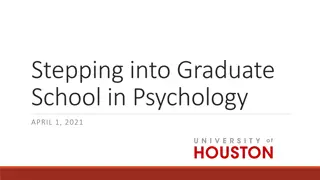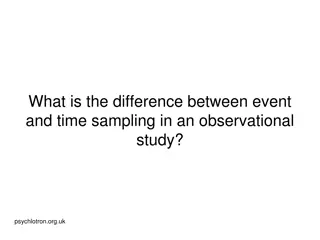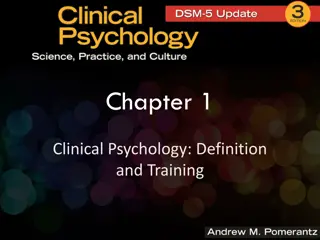
Psychology Department Learning Outcomes and Solutions
"Explore the challenges faced by the U of U Psychology Department in defining learning outcomes, and learn about the innovative solutions implemented to address these issues. Discover the qualitative approach used to evaluate assignments and foster academic success among students." (Total characters: 247)
Uploaded on | 3 Views
Download Presentation

Please find below an Image/Link to download the presentation.
The content on the website is provided AS IS for your information and personal use only. It may not be sold, licensed, or shared on other websites without obtaining consent from the author. If you encounter any issues during the download, it is possible that the publisher has removed the file from their server.
You are allowed to download the files provided on this website for personal or commercial use, subject to the condition that they are used lawfully. All files are the property of their respective owners.
The content on the website is provided AS IS for your information and personal use only. It may not be sold, licensed, or shared on other websites without obtaining consent from the author.
E N D
Presentation Transcript
Learning Outcomes in the U of U Psychology Department M. Pasupathi With help from the 2016-2017 UG committee: DeBoeck, Dekoejer-Laros, Himle, Rand, Weeks
The Issues Lack of resources and limitations on the best test IDEAL: Pre- and post-test design with control group of non-majors ISSUE: no resources to support purchase or development of measures; no ideal measures of some learning outcomes ISSUE: no way around selection biases in who pursues the major
The Issues Horizontally branching major Only four courses required of all majors thus diversity in coursework and exposure to relevant assignments As a hub science knowledge builds outwards, not upwards few options for comparing freshmen/sophomore students with junior/senior students on similar work.
The Issues LARGE major Heavy reliance on exams (often multiple choice) Limits potential of a focus on student artifacts for some of our learning outcomes (e.g., knowledge).
Our Working Solutions Use qualitative methods Scope for comparing apples to oranges More wide-ranging discussion Focus when possible on classes required of all majors Sample assignments with good and poor grades Complement looking at student work with Looking at assignments and exams Asking for student evaluations of courses on learning outcomes
Qualitative approach Artifacts representing assignments at different levels in the major, pertinent to a specific learning outcome. Review as a committee, discuss what we see as similar and distinct, how we think the assignments and artifacts do, or do not, promote the learning outcome. Emphasize multiple viewpoints of committee members and craft a consensus perspective
Initial Findings Develop a thorough and broad knowledge base of psychological concepts Demonstrate competence in scientific Inquiry and Critical Thinking Demonstrate ethical and social responsibility in a diverse world Develop strong written and oral communication skills Apply foundational knowledge and skills to career/professional development
Initial Findings, cont Outcomes of the Initial Evaluation No student assignments that reflected ethics/social responsibility. Could work on create more career/professional development experiences. Look at broadening writing/communication experiences Students perceptions of how classes contribute to learning outcomes do not always match faculty views. E.g., students perceive the core content courses as most relevant to career development, NOT the career-focused 2010 course.
Next Steps Tackling the horizontal, branching major problem: Identify ways to ensure that most students will make choices within the major that expose them to particular content conditional probability analyses?






















